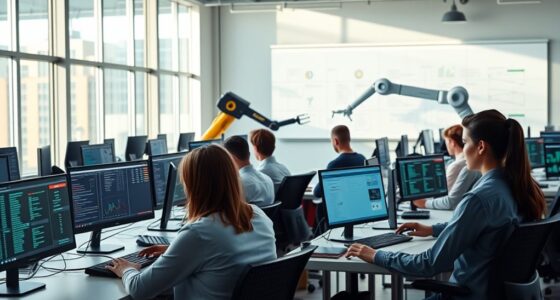In an AI-driven testing case study, you’ll see how automation speeds up bug detection and improves test coverage, making your development cycle more efficient. AI analyzes large amounts of code and user data to identify risky areas, prioritizing tests and learning from past runs to adapt as the project evolves. It provides instant feedback, uncovers hidden issues, and enhances security. To discover how these innovations can reshape your projects, keep exploring further.
Key Takeaways
- AI-enabled test automation accelerated bug detection and reduced manual effort, improving overall testing efficiency in the project.
- Predictive analysis prioritized high-risk code areas, optimizing resource allocation and test coverage.
- Real-time feedback identified vulnerabilities early, shortening development cycles and enhancing product security.
- Exploratory testing simulated diverse user scenarios, uncovering edge cases and hidden issues for increased robustness.
- The AI-driven approach resulted in faster time-to-market and higher software quality, demonstrating significant project improvements.

Artificial intelligence is transforming software testing by enabling faster, more precise detection of bugs and vulnerabilities. When you implement AI-driven testing, you harness the power of advanced algorithms to enhance test automation, which streamlines your entire quality assurance process. This shift means you can identify issues more quickly and reliably than traditional manual testing methods, saving time and reducing human error. By integrating AI into your testing workflows, you empower your team to focus on more complex problem-solving rather than repetitive test cases.
In a typical project, AI-driven testing tools analyze vast amounts of code and user data to predict areas prone to errors. This predictive capability allows you to prioritize testing efforts on high-risk sections, increasing overall efficiency. Test automation becomes smarter as AI learns from previous test runs, continuously improving test coverage and accuracy. Instead of writing and running static test scripts, you leverage machine learning models that adapt to changes in your codebase, ensuring your tests stay relevant as your software evolves. This adaptability markedly reduces the maintenance overhead associated with traditional test scripts.
Moreover, AI enhances quality assurance by providing real-time feedback during development cycles. As you push new code, AI-powered systems automatically execute tests, detect anomalies, and flag potential vulnerabilities almost instantaneously. This immediate response accelerates your development pipeline, enabling quicker iterations and faster releases. The automation of these processes not only saves resources but also minimizes the risk of overlooking critical bugs that might slip through manual testing stages. Additionally, AI can help identify patterns of failure that might be difficult for humans to detect, further improving testing accuracy. These capabilities also facilitate comprehensive testing across diverse scenarios, ensuring a higher level of software robustness.
You also benefit from AI’s ability to perform exploratory testing, which traditionally relies on human intuition. AI tools can simulate various user behaviors and environments, uncovering edge cases and hidden issues that might be missed otherwise. This thorough testing approach ensures your software is robust across different scenarios, boosting your confidence in its stability and security. Additionally, AI-driven insights help you understand the root causes of failures, guiding your team to implement effective fixes more efficiently. Implementing security measures is also crucial to safeguard your testing environment from cyber threats and data breaches.
In this case study, adopting AI for test automation and quality assurance transformed the way testing was approached. It provided a scalable, intelligent framework that adapts to changing project needs, reduces time-to-market, and improves product quality. The integration of AI in your testing process exemplifies how modern software development benefits from intelligent automation, ultimately delivering more reliable, secure, and user-friendly applications. Moreover, incorporating well-being solutions into team workflows can help maintain productivity and morale during intensive testing phases, ensuring a healthier work environment. Additionally, staying updated with emerging AI technologies can help your team continuously improve testing strategies and outcomes.
Frequently Asked Questions
How Does AI Improve Testing Accuracy Over Traditional Methods?
AI improves testing accuracy by leveraging machine learning to identify patterns and predict potential issues more precisely than traditional methods. It continuously learns from testing data, enabling better test optimization. This adaptive approach minimizes human error, detects subtle bugs, and enhances coverage. As a result, you get more reliable results faster, with fewer false positives and negatives, making your testing process more efficient and accurate overall.
What Are the Initial Costs of Implementing Ai-Driven Testing?
When considering the initial costs of AI-driven testing, you need to account for the initial investment in hardware, software, and tools. Training expenses are also significant, as your team must learn new technologies and methodologies. While these upfront costs can be substantial, they often lead to long-term savings through enhanced testing accuracy and efficiency. Preparing for these expenses helps you make informed decisions about adopting AI in testing processes.
How Does AI Handle Complex or Unpredictable Software Behaviors?
You might wonder how AI manages complex or unpredictable software behaviors. AI handles this through heuristic adaptation, allowing it to learn from new patterns and adjust testing strategies. Anomaly detection helps identify unexpected or abnormal behaviors that could indicate bugs. By combining these techniques, AI can effectively navigate unpredictable scenarios, ensuring extensive testing and minimizing missed issues without exhaustive manual effort.
What Are Common Challenges Faced During AI Integration in Testing?
Think of AI integration as fitting together a complex puzzle—you might struggle with tool compatibility or data privacy issues. You’ll often face challenges like ensuring AI tools seamlessly work with existing systems and protecting sensitive data. These hurdles require careful planning, constant monitoring, and compliance with privacy standards. Overcoming these problems helps you open AI’s full potential in testing, making your processes smarter and more efficient.
How Is Ai-Driven Testing Scaled for Large or Evolving Projects?
You face scalability challenges when expanding AI-driven testing for large or evolving projects. To handle this, you should adopt robust integration strategies like modular architecture and automation pipelines that support growth. Continuously monitor performance and adapt your AI models accordingly. By planning for scalability early, you guarantee your testing remains efficient, reliable, and adaptable as project size and complexity increase.
Conclusion
As you wrap up this journey through AI-driven testing, remember it’s like having a vigilant lighthouse guiding your project safely through stormy waters. Embracing AI tools accelerates your testing process, uncovers hidden bugs, and boosts your confidence in software quality. By integrating AI into your workflow, you turn complex challenges into manageable waves, steering your project smoothly toward success. Ultimately, AI becomes your steadfast partner, illuminating the path to better, faster software development.









